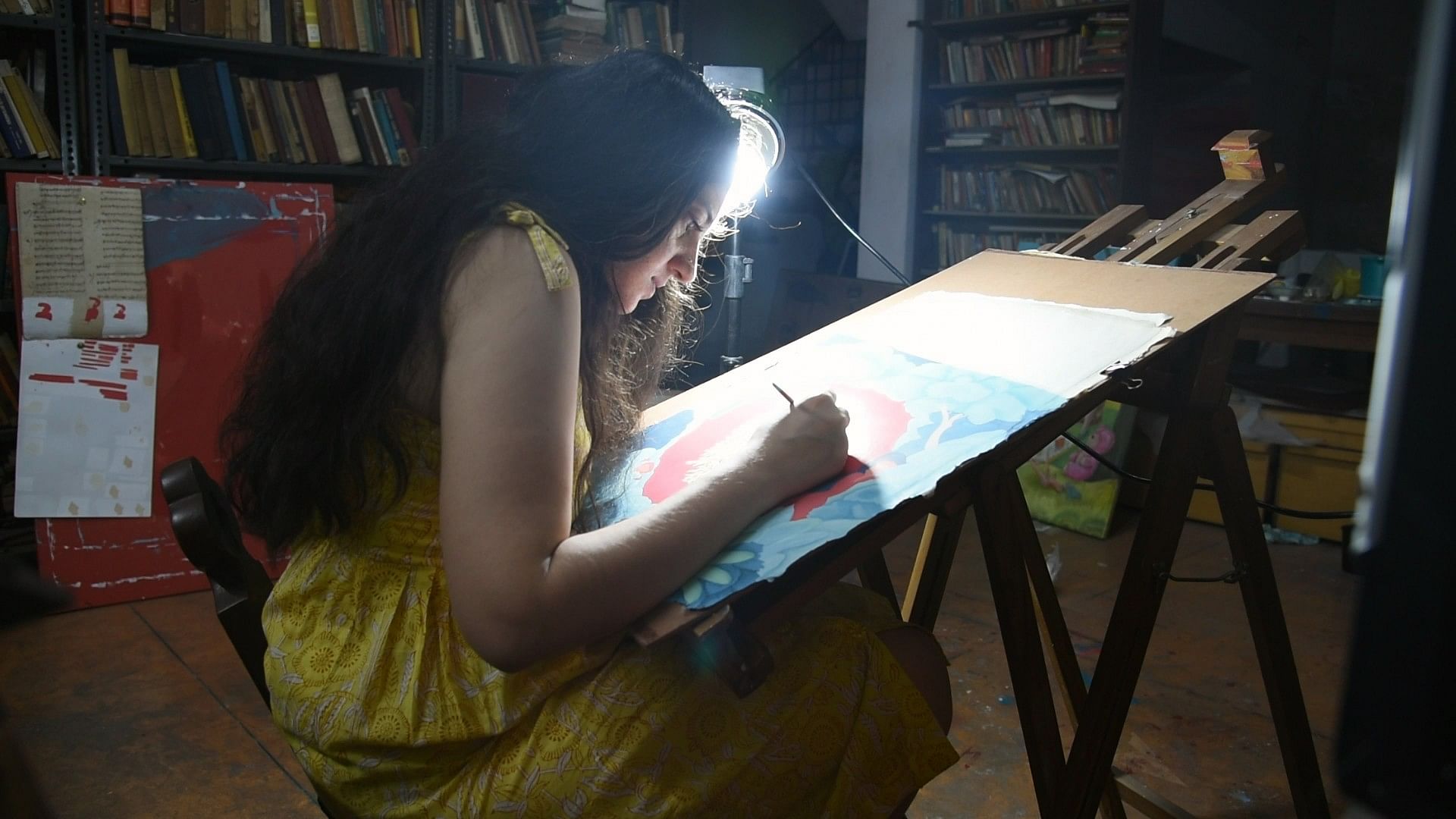
Gargi Chandola’s last series shows monkeys mimicking human behaviour.
Credit: Yaman Navlakha
Indian miniature paintings are seeing a revival. Artists are slowly experimenting with new themes and stepping away from conventional painting surfaces and media.
India has several miniature schools of paintings, including Deccan, Pahari, Mughal, Orissa, Rajasthani, Jain, Surpura, and Pala, among others. A look at what makes these traditions unique and how they are evolving.
Kangra style
The Pahari school of painting originated in the lower Himalayan reaches of north India and the plains of Punjab. It includes sub-schools like Basohli, Mankot, Nurpur, Chamba, Kangra, Guler, Mandi and Garhwal.
Pahari miniatures mostly depict themes from Hindu mythology such as the life of Krishna and also scenes from classical literature. “These paintings are often visual interpretations of spiritual or romantic texts. The richly imagined landscapes are a perfect setting for depicting love poems like the 18th century ‘Gita Govinda’ series by Jaiyadeva,” she notes.
The Kangara style in particular draws inspiration from the romance between lord Krishna and Radha. Gargi Chandola was drawn to the Kangra style because of how meticulously “the foliage (was) illustrated”. After collaborating with artists from different schools of miniatures, Gargi started training in the Kangra form around three years ago.
In these miniatures, nature is used as a metaphor to depict the various moods of lovers. “Kangra artworks are primarily about ‘shringara’ (love),” she notes. Depiction of grand architecture, palace scenes and historical wars are rarely found in Pahari miniatures, Gargi points out.
As for design nuances, Pahari miniatures position the ‘nayak’ and/or ‘nayika’ (protagonist and/or female protagonist) at the centre of the painting. “Attention is given to details like the jewellery, clothing, and facial features. Human figures in Pahari miniatures are created with delicate yet well-defined lines,” she elaborates. Elongated eyes, slim waists, and stylised features are common to Pahari figures.
Trees are another recurrent motif. These feature fluid brushwork using watercolours and minute detailing on leaves and flowers, she adds.
Gargi’s last series was a departure from the traditional themes. The paintings delved into “human notions of territory and power and the isolation of mind and body”. “In the works, the monkeys mimic human behaviour. They are a reflection of self, engaging in petty and perverse mind games as well as violence and trickery to get to the bananas,” she explains. Bananas and their phallic shape are “a recurring tool to establish dominance” in the works, she adds.
Mughal and Rajput styles
Jaipur-based artist Riyazuddin practices two schools of miniature painting — Mughal and Rajput. The Mughal paintings are prized for their realistic depiction of people and things around us. They make use of pale colours. However, the Rajput style uses vibrant colours and does not focus on replicating anatomical features. These paintings often feature people with big moustaches and turbans in plain backdrops. Court and hunting scenes and religious themes are common to these schools.
“The Rajput school has around 15 sub-schools under it. Natural elements like malachite stone, turquoise, indigo and copper rust are used to derive colours for the Rajput artworks,” says Riyazuddin.
The Mughal-style paintings are inspired by flowers, costumes and buildings and feature fine detailing. He makes portraits of emperors and Sufi artistes in his Mughal artworks.
Remarking on the difference between the two schools, he says if you were to look at a Mughal portrait on a bearded person, you can see every strand in the beard. While Riyazuddin takes around one to three days to work on Rajput paintings, he needs a minimum of a week to complete Mughal artwork. Rajput works are done on special paper sourced from cities like Udaipur while Mughal works are made on fine paper from Kashmir, and Sialkot in Pakistan.
Riyazuddin has experimented with both the styles. He has made Mughal works on glass, jars, steel, and brass surfaces. “I will be doing Mughal work on wooden trays soon,” he adds.
One of his latest experiments with the Rajput style included a project he recently displayed at Kaash, an art space in Bengaluru. The paintings were rooted in the visual language of the Rajput style but were made on untreated parchment leather. The result was an illuminated leather artwork, featuring miniature paintings of gods on them.
Surpura style
The Surpura school of miniature painting bears strong similarities with Mysore and Tanjore style of paintings. It started by depicting Hindu religious and mythological subjects. In later years, royalty emerged as another popular theme.
Artist Dr Vijay Siddramappa Hagargundgi has worked on drawings and paintings in the Surpura style for more than 40 years. His favourite subjects come from religious and Sanskrit texts like ‘Shivapurana’, ‘Dashavatara’, ‘Navagraha’, ‘Ashta Dikpalakas’, ‘Ashtanayikas’, and ‘Kamasutra’.
While he is known for the Surpura style, he often looks up to Basoli, Kongda, Rajput, Malwa, Jain and Deccan schools for inspiration. Vijay’s recent works include a series of miniatures on ‘Panchabhutas’. These paintings included depictions of the five elements ‘agni’ (fire), ‘akasha’ (space), ‘vayu’ (air), ‘jala’ (water), and ‘bhoomi’ (earth).
His works have been mounted in museums and exhibitions across the globe. “Clients who do not mind paying for the intricate work and quality are (my) usual customers,” he says, commenting on the growing demand for miniature paintings.
What are miniature paintings?
Indian miniatures are small-scale paintings done with great detail. They can be traced back to at least 9th century CE. Miniatures were painted on manuscripts made out of dried palm leaves or on the cloth before the paper came to India. Miniature styles from different eras and areas have influenced each other. Most miniature paintings are influenced by epics, fables, and religious texts.